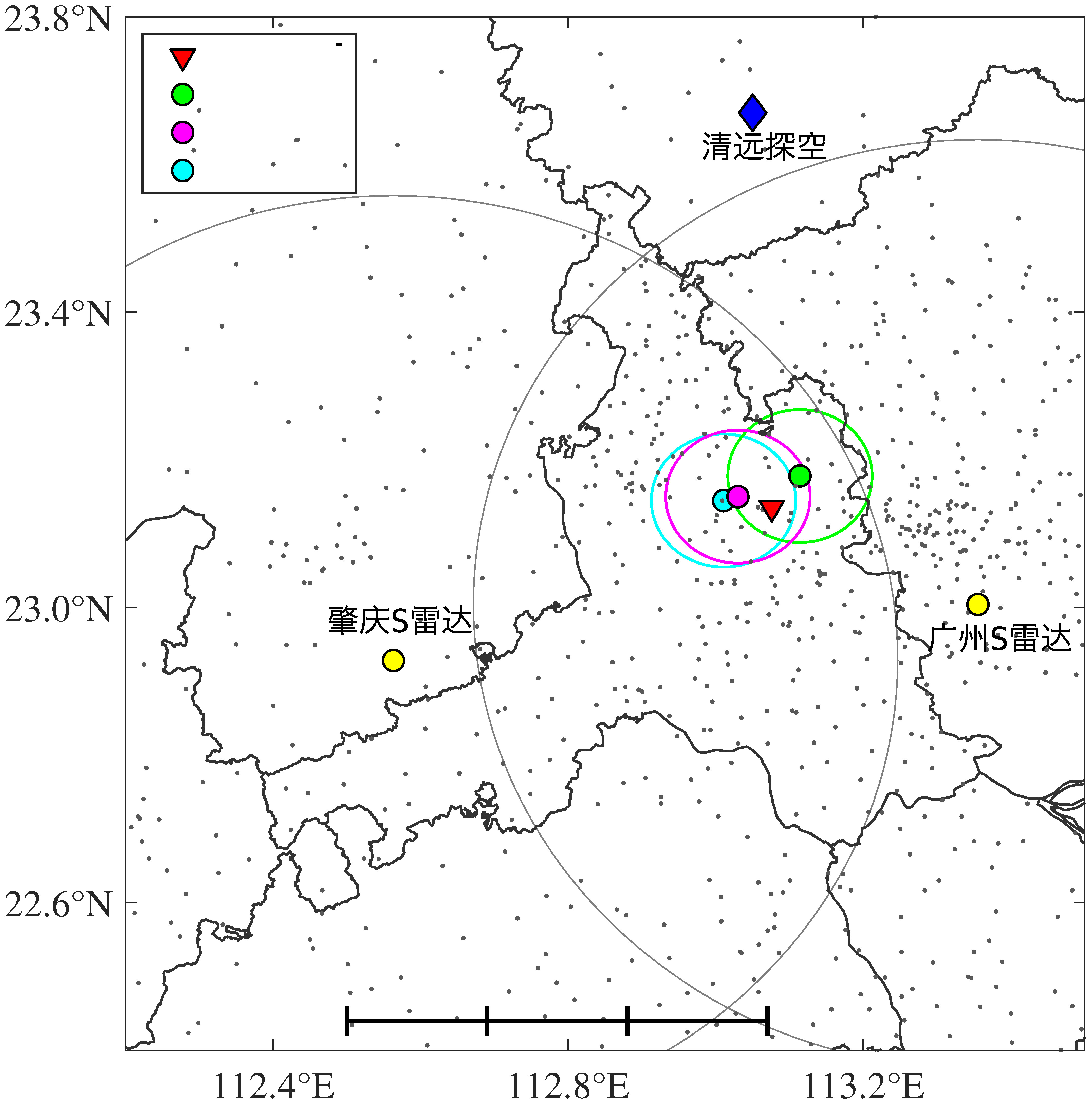Multiple radar observations and formation environment of a weak tornadic storm associated with a boundary layer convergent line
-
摘要: 2022年6月30日下午,佛山市南海区遭受EF0级龙卷风袭击,本研究基于邻近此地区三部不同体制的X波段雷达和两部S波段双极化雷达、地面气象站和大气再分析数据等资料,系统研究了该龙卷风暴的多波段、多体制雷达观测特征及关键生成环境。由于五部雷达均未识别到中层中气旋特征,表明该个例为非中气旋龙卷风。通过多波段雷达观测对比发现,S波段雷达对这一短时龙卷风的探测能力极其有限,未能识别龙卷涡旋特征(TVS),而X波段雷达凭借更高的低空探测覆盖率和径向空间分辨率,对此类弱龙卷风暴精细结构的捕捉具有显著优势。与X波段多体制雷达对比发现,X波段机械雷达因其更高的发射功率和更窄波束宽度,可以探测到更加清晰的TVS和“弱回波眼区”等关键结构;而具有快速扫描优势的X波段相控阵雷达,受限于较小的发射功率和相对较宽的波束宽度,对弱龙卷风涡旋特征的探测相对不足。进一步研究发现,本次龙卷母体对流风暴位于热带气旋“暹芭”外围环流与西风带系统相互作用的过渡区内。雷达低层径向风和地面风场观测表明,该龙卷风暴由边界层内辐合切变线动力强迫抬升而激发,形成于辐合线上直径约4~6 km的微气旋内,因此本次非中气旋龙卷风可能是由近地面微气旋受低层垂直上升气流拉伸增强所致。Abstract: On the afternoon of 30 June 2022, an EF0 tornado struck Nanhai District, Foshan. Utilizing data from three X-band Doppler weather radars of distinct hardware standards, two additional S-band dualpolarization radars, surface meteorological stations, and atmospheric reanalysis products, the key multiple radar observational characteristics and the convective environment associated with this tornadic storm were systematically investigated. Results showed that no mid-level mesocyclone signatures were identified by any of the five radars, confirming this event as a non-mesocyclone tornado. Comparing with X-band radar observations, the S-band radars exhibited limited capability in detecting vortex signatures associated with the tornado and failed to identify tornado vortex signature (TVS). In contrast, the higher spatial-temporal resolution and enhanced low-level coverage of the X-band radars showed superior advantages in detecting such tornadic fine-scale structures. Comparisons of these X-band radars revealed that, the mechanicalscanning antennas, equipped with higher transmit power and narrower beamwidth, appeared to provide clearer features of TVS and weak-echo eye during this weak tornado. Although being advantageous in rapid scanning, it was relatively harder to capture such weak TVS features through the phased array Xband radars due to the lower transmit power and broader beamwidth. Further studies revealed that the tornado developed in a transition zone between the outer large-scale cyclonic circulation of Typhoon Chaba and the upper-level prevailing westerlies. Doppler products and surface wind observations suggested that the tornadic storm was triggered by the upward forcing along a convergence line within the boundary layer, and this tornado formed within a misocyclone approximately 4-6 km in diameter. Consequently, these findings infer that the near-surface mesocyclone, which was enhanced by the stretching of the preexisting low-level ambient vertical vorticity, led to the non-mesocyclone tornado.
-
Key words:
- non-mesocyclone tornado /
- phased array radar /
- convergence line /
- misocyclone /
- tropical cyclone
-
图 2 2022年6月30日佛山狮山镇颜峰社区龙卷实拍照片(a)和实际灾害照片(b),以及17:00 LST华南雷达组合反射率拼图(c)
红色三角形是龙卷风所在位置。其中,(c)中所用雷达组合反射率由中国气象局雷达气象中心制作。为体现具体的行政区域边界和叠加龙卷风发生位置等信息,本文通过下载中央气象台官网的华南区域雷达拼图,并参考Bai等[26]的方法进行重新绘制。
图 6 2022年6月30日16:44佛山3部X波段雷达的反射率因子图(左)和径向速度图(右)。第一行、第二行、第三行分别对应表 1中的雷达#1、雷达#2、雷达#3
红圈为龙卷风地面位置,黑色三角为雷达所在位置。
表 1 本研究所用多普勒天气雷达的相关技术参数
名称 雷达#1 雷达#2 雷达#3 肇庆/广州雷达 波段 X X X S 技术体制 相控阵全相参 相控阵全相参 机械扫描全相参 机械扫描全相参 极化方式 水平、垂直双极化 水平、垂直双极化 水平、垂直双极化 水平、垂直双极化 发射机峰值功率 320 W 400 W 75 kW 650 kW 波束宽度 水平1.8 °,垂直1.8 ° 水平3.6 °,垂直1.8 ° 水平0.93 °,垂直1 ° 水平1 °,垂直1 ° 时间分辨率 60 s 60 s 120 s 360 s 径向分辨率 30 m 30 m 75 m 250 m 方位角分辨率 1.6 ° 3.6 ° 0.9 ° 0.5 ° 仰角层数 48层 34层 5层 9层 有效探测半径 40 km 60 km 75 km 230 km 最低仰角最大不模糊速度 36 m·s-1 19.8 m·s-1 31.6 m·s-1 26.6 m·s-1 表 2 2022年6月30日08时清远探空站环境参数,其中CAPE等对流参数是基于气块从地面抬升计算所得
CAPE(对流有效位能)/(J·kg-1) CIN(对流抑制)/(J·kg-1) LCL(抬升凝结高度)/m LFC(自由对流高度)/m SHR(垂直风切变)/(m·s-1) SRH(风暴相对螺旋度)/(m2·s-2) 0~1 km 0~6 km 0~1 km 0~3 km 1773 5.3 317 81 4.1 4.4 34.8 47.9 表 3 Thompson等统计的非超级单体风暴垂直风切变值
物理量 最大值/(m·s-1) 最小值/(m·s-1) 平均值/(m·s-1) SHR(垂直风切变,0~1 km) 4.9 1.1 2.9 SHR(垂直风切变,0~6 km) 14.3 3.6 7.8 -
[1] 中国气象局, 地面气象观测规范[M]. 北京: 气象出版社, 2003: 11. [2] 刁秀广, 万明波, 高留喜, 等. 非超级单体龙卷风暴多普勒天气雷达产品特征及预警[J]. 气象, 2014, 40(6): 668-677. [3] 郭泽勇, 张弘豪, 胡胜, 等. 华南一次非中气旋海面龙卷的大气条件和雷达特征分析[J]. 热带气象学报, 2021, 37(4): 541-555. [4] 王秀明, 俞小鼎. 热带一次致灾龙卷形成物理过程研究[J]. 气象学报, 2019, 77(3): 387-404. [5] 戴建华, 王国荣, 龚剑, 等. 梅雨锋中尺度涡旋内微型超级单体龙卷的形成研究[J]. 热带气象学报, 2021, 37(5-6): 693-709. [6] 俞小鼎, 郑永光. 中国当代强对流天气研究与业务进展[J]. 气象学报, 2020, 78(3): 391-418. [7] 白兰强, 孟智勇, SUEKI K, 等. 中国热带气旋龙卷的气候统计特征(2006~2018)[J]. 中国科学: 地球科学, 2020, 50(5): 619-634. [8] 慕瑞琪, 徐芳, 孙康远, 等. 江苏台风龙卷环境条件与雷达关键特征分析[J]. 气象, 2022, 48(2): 190-202. [9] 史达伟, 李超, 韩桂荣, 等. 1710号台风"海棠"前部龙卷天气分析[J]. 海洋预报, 2018, 35(5): 53-59. [10] 慕瑞琪, 吴海英, 李杨, 等. 2020年7月22日苏北地区EF2~EF3级龙卷天气分析[J]. 热带气象学报, 2021, 37(5-6): 759-769. [11] 何彩芬, 姚秀萍, 胡春蕾, 等. 一次台风前部龙卷的多普勒天气雷达分析[J]. 应用气象学报, 2006, 17(3): 370-375. [12] 黄先香, 俞小鼎, 炎利军, 等. 1804号台风"艾云尼"龙卷分析[J]. 气象学报, 2019, 77(4): 645-661. [13] 黄先香, 俞小鼎, 炎利军, 等. 珠江三角洲台风龙卷的活动特征及环境条件分析[J]. 气象, 2019, 45(6): 777-790. [14] 郑媛媛, 张备, 王啸华, 等. 台风龙卷的环境背景和雷达回波结构分析[J]. 气象, 2015, 41(8): 942-952. [15] 俞小鼎, 赵娟, 范雯杰. 中国龙卷的时空分布与关键环境参数特征[J]. 热带气象学报, 2021, 37(5-6): 681-692. [16] 郑永光, 刘菲凡, 张恒进. 中国龙卷研究进展[J]. 气象, 2021, 47(11): 1 319-1 335. [17] BAI L Q, MENG Z Y, ZHOU R L, et al. Radar-based characteristics and formation environment of supercells in the landfalling Typhoon Mujigae in 2015[J]. Adv Atmos Sci, 2022, 39(5): 802-818. [18] BAI L Q, MENG Z Y, HUANG L, et al. An integrated damage, visual and radar analysis of the 2015 Foshan, Guangdong, EF3 tornado in China produced by the landfalling Typhoon Mujigae (2015)[J]. Bull Amer Meteor Soc, 2017, 98: 2 619-2 640. [19] YAO D, LIANG X D, MENG Q, et al. Importance of identifying tropical cyclone tornadoes in typhoon warning and defense systems[J]. Sci Bull, 2019, 64(3): 143-145. [20] 蒋义芳, 吴海英, 沈树勤, 等. 0808号台风凤凰前部龙卷的环境场和雷达回波分析[J]. 气象, 2009, 35(4): 68-75. [21] 黄先香, 炎利军, 顾伯辉, 等. 广东一次超级单体强龙卷的形成环境和观测特征分析[J]. 热带气象学报, 2021, 37(5-6): 721-732. [22] 王艺娟, 姚聃, 梁旭东, 等. 2021年苏州与武汉两地龙卷的环境条件与雷达特征对比分析[J]. 暴雨灾害, 2023, 42(4): 415-426. [23] 傅佩玲, 胡东明, 黄浩, 等. 台风山竹(1822)龙卷的双极化相控阵雷达特征[J]. 应用气象学报, 2020, 31(6): 706-718. [24] 刘健文, 郭虎, 李耀东, 等. 天气分析预报物理量计算基础[M]. 气象出版社, 2005. [25] 郑永光, 朱文剑, 姚聃, 等. 2016. 风速等级标准与2016年6月23阜宁龙卷强度估计[J]. 气象, 42(11): 1 289-1 203. [26] BAI L Q, CHEN G X, HUANG L. Image processing of radar mosaics for the climatology of convection initiation in South China[J]. J Appl Meteor Climatol, 2020, 59(1): 65-81. [27] 范雯杰, 俞小鼎. 中国龙卷的时空变化特征[J]. 气象, 2015, 41(7): 793-805. [28] THOMPSON R L, EDWARDS R, HART J A, et al. Close proximity soundings within supercell environments obtained from the rapid update cycle[J]. Wea Forecasting, 2003, 18(6): 1 243-1 261. [29] DAVIES-JONES R. Streamwise vorticity: The origin of updraft rotation in supercell storms[J]. J Atmos Sci, 1984, 41(20): 2 991-3 006. [30] MARQUIS J N, RICHARDSON Y P, WURMAN J M. Kinematic observations of misocyclones along boundaries during IHOP[J]. Mon Wea Rev, 2007, 135(5): 1 749-1 768. [31] FUJITA T T. Tornadoes and downbursts in the context of generalized planetary scales[J]. J Atmos Sci, 1981, 38(8): 1 511-1 534. [32] KOBAYASHI F, SUGAWARA Y, IMAI M, et al. Tornado generation in a narrow cold frontal rainband -Fujisawa Tornado on April 20, 2006 -[J]. Sci Online Lett Atmos, 2007, 3(2): 21-24. [33] LEE B D, WILHELMSON R B. The numerical simulation of non-supercell tornadogenesis. Part I: Initiation and evolution of pretornadic misocyclone circulations along a dry outflow boundary[J]. Atmos Sci, 1997, 54(1): 32-60. [34] 郑永光. 中国龙卷气候特征和环境条件研究进展综述[J]. 气象科技进展, 2020, 10(6): 69-75. [35] 唐晓文, 李峰, 刘高平. 龙卷形成过程及母体风暴结构与演变研究进展[J]. 成都信息工程大学学报, 2018, 33(6): 599-605. -






 下载:
下载:














 粤公网安备 4401069904700003号
粤公网安备 4401069904700003号